What is the difference between cartoons and animation?

Difference Between Cartoons and Animation
The terms cartoons and animation are often used interchangeably, but they have different meanings:
Cartoons
- Definition: Cartoons refer to illustrated or drawn images, typically characterized by exaggerated features, humor, or satire. They can be static (like comic strips or editorial cartoons) or moving (as in animated cartoons).
- Usage: Cartoons often describe humorous or satirical visual art in newspapers, magazines, and television.
- Style: The cartoon style is typically simple, exaggerated, or stylized, focusing on entertainment, humor, or political/social commentary.
Animation
- Definition: Animation is a technique or process of making inanimate objects or drawings appear to move. It encompasses all methods of creating moving images, including traditional hand-drawn, computer-generated, stop-motion, and more.
- Usage: Animation is a broad term that covers any moving image created frame by frame, regardless of style or subject matter.
- Scope: Animation can be realistic, abstract, or stylized, and is used in movies, TV, advertising, video games, and more.
Key Differences
- Cartoon refers mainly to the style or genre of the artwork, often humorous and exaggerated.
- Animation refers to the process or technique of bringing images to life, which can include cartoons but also encompasses much more (such as realistic 3D animation).
In summary, all moving cartoons are animations, but not all animations are cartoons. Cartoons are a subset of animation, usually defined by their artistic style and intent.